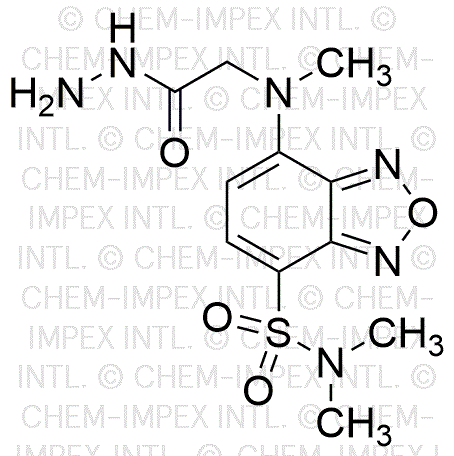4-(N,N-Dimethylaminosulfonyl)-7-(N-hydrazinocarbonylmethyl-N-methyl)amino-2,1,3-benzoxadiazole is widely utilized in research focused on:
- Fluorescent Probes: This compound serves as a fluorescent probe in biological imaging, allowing researchers to visualize cellular processes with high specificity and sensitivity.
- Drug Development: It plays a role in the synthesis of novel pharmaceuticals, particularly in targeting specific enzymes or receptors, enhancing the efficacy of drug candidates.
- Analytical Chemistry: The compound is used in analytical methods for detecting and quantifying biomolecules, providing precise measurements that are crucial for research and quality control.
- Environmental Monitoring: It aids in the detection of pollutants in environmental samples, helping industries comply with regulatory standards and ensuring public safety.
- Bioconjugation: This chemical is employed in bioconjugation techniques, linking biomolecules for therapeutic applications, which can improve drug delivery and targeting.
General Information
Properties
Safety and Regulations
Applications
4-(N,N-Dimethylaminosulfonyl)-7-(N-hydrazinocarbonylmethyl-N-methyl)amino-2,1,3-benzoxadiazole is widely utilized in research focused on:
- Fluorescent Probes: This compound serves as a fluorescent probe in biological imaging, allowing researchers to visualize cellular processes with high specificity and sensitivity.
- Drug Development: It plays a role in the synthesis of novel pharmaceuticals, particularly in targeting specific enzymes or receptors, enhancing the efficacy of drug candidates.
- Analytical Chemistry: The compound is used in analytical methods for detecting and quantifying biomolecules, providing precise measurements that are crucial for research and quality control.
- Environmental Monitoring: It aids in the detection of pollutants in environmental samples, helping industries comply with regulatory standards and ensuring public safety.
- Bioconjugation: This chemical is employed in bioconjugation techniques, linking biomolecules for therapeutic applications, which can improve drug delivery and targeting.
Documents
Safety Data Sheets (SDS)
The SDS provides comprehensive safety information on handling, storage, and disposal of the product.
Product Specification (PS)
The PS provides a comprehensive breakdown of the product’s properties, including chemical composition, physical state, purity, and storage requirements. It also details acceptable quality ranges and the product's intended applications.
Certificates of Analysis (COA)
Search for Certificates of Analysis (COA) by entering the products Lot Number. Lot and Batch Numbers can be found on a product’s label following the words ‘Lot’ or ‘Batch’.
Numéro de catalogue
Numéro de lot/série
Certificates Of Origin (COO)
This COO confirms the country where the product was manufactured, and also details the materials and components used in it and whether it is derived from natural, synthetic, or other specific sources. This certificate may be required for customs, trade, and regulatory compliance.
Numéro de catalogue
Numéro de lot/série
Safety Data Sheets (SDS)
The SDS provides comprehensive safety information on handling, storage, and disposal of the product.
DownloadProduct Specification (PS)
The PS provides a comprehensive breakdown of the product’s properties, including chemical composition, physical state, purity, and storage requirements. It also details acceptable quality ranges and the product's intended applications.
DownloadCertificates of Analysis (COA)
Search for Certificates of Analysis (COA) by entering the products Lot Number. Lot and Batch Numbers can be found on a product’s label following the words ‘Lot’ or ‘Batch’.
Numéro de catalogue
Numéro de lot/série
Certificates Of Origin (COO)
This COO confirms the country where the product was manufactured, and also details the materials and components used in it and whether it is derived from natural, synthetic, or other specific sources. This certificate may be required for customs, trade, and regulatory compliance.


